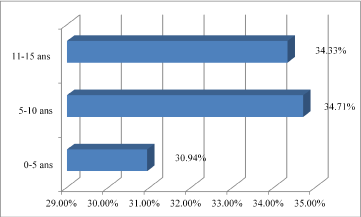Road traffic accident is a great public health problem in the world. According to the WHO, road traffic accidents worldwide account for 1.2 million deaths and 50 million injuries per year. Africa ranks first in terms of victims, with 28 deaths per 100,000 habitants. According to a WHO study, between 1990 and 2020: Traffic accidents will become the sixth leading cause of death worldwide and will also become the third leading cause of disability .They will become the second leading cause of loss of life years adjusts on disability in low- and middle-income countries [1-3]. The aim of this study was to study the epidemiological, clinical and therapeutical aspects of trauma related to road accidents in children admitted to the emergency unit of Niamey National Hospital.
The prospective study was conducted in the emergency unit of Niamey National Hospital (NNH). Data was gathered from January to December 2013. Were included all children between 0 to 15 years admitted to the surgical emergency unit for injuries related to road accidents , were excluded victims who died in pre-hospital. The following variables were analyzed: age, sex, provenance, level of education, type and time of accident, time of admission, lesions, treatment, duration stay in emergency, and expenses. Data were analyzed with Epi-Info 6TM (Centers for Disease Control and Prevention, Atlanta, GA.
The sample included 1034 patients, aged 0 to 15 years out of 2546 victims of traffic accidents admitted to the NNH surgical emergencies (40.61% of the victims). The locations of the accident were the urban community of Niamey in 95.79%; 1.15% came from the region of Tillabéry which borders Niamey. The average age was 8 ± 3 years with extremes ranging from 12 weeks to 15 years. (Figure 1) Males represented 71%, with a male to female ratio of 2.44:1. This male predominance is found in all age groups. 54.15% of our patients were schoolboys. Accidents occurred most often between 2: AM to 6: PM in 42.64% of the cases. The mechanism of the accident was car-pedestrian in 34.42%, motor-pedestrian in 33.84% (Table 1) Pre-hospital transportation was provided by a private vehicle in 40.6% of the cases, taxi in 38.20%, by firefighters and paramedics in respectively 13.60% and 4.70%. The transport was done by the SAMU in 2.90% of our patients. Admission was in less than one hour in 89.16% of patients. Closed trauma represented 79.10%, open trauma 19.90% and associations 1%. Cerebral injury was the most common lesion with 33.94% followed by limb trauma seen in 18.37% of patients. (Table 2)

Figure 1. Distribution of patients by age.
Table 1. Distribution of patients by type of accident.
Accident |
Effective |
Percentage % |
Auto-pedestrian |
356 |
34,42 |
Motorbike – pedestrian |
350 |
33,84 |
Auto - motorbike |
135 |
13,05 |
Motorbike fall |
55 |
5,31 |
Motorbikes collision |
45 |
4,35 |
Bicycle |
26 |
2,51 |
Auto reversed |
22 |
2,12 |
Auto collision |
14 |
1,35 |
Autres |
31 |
2,99 |
TOTAL |
1034 |
100% |
Table 2. Distribution of patients according to the seat of the lesion
Trauma |
Effective |
Percentage % |
Skull |
351 |
33,94 |
Limbs |
190 |
18,37 |
Abdomen |
57 |
5,51 |
Basin |
54 |
5,22 |
Rachis |
50 |
4,83 |
Thorax |
45 |
4,35 |
Associations |
287 |
27,75 |
Total |
1034 |
100% |
In our study, 45.97% of patients had received a2021 Copyright OAT. All rights reserve most common analgesic used was paracetamol alone (53.03%) or associated to codeine (33.85%). 35.62% of patients received antibiotic, and 2.42% of patients were sedated. Blood transfusion involved 0.31% of patients. Surgical treatment was a simple suture in 79.87% of cases, a plastered Immobilization in 47.67%. The osteosynthesis involved 5.48% of patients, laparotomy 4.87%, thoracic drainage 3.04% and limb amputation 1.40%. 50.8% of patients had stayed between 1 and 8 hours in the emergency care unit, 84.20% of the patients had a hospital stay of less than 24 hours. Eight cases of death (0.77%) were recorded. The cost of care ranged between 15 and 60 US $ for 42.77% of patients with an average cost of 50 US $, keeping in mind that health care is free for children below 5 years of age in Niger.
Trauma related to road traffic accidents in children is common in surgical emergency department. The pedestrian on the school path is the most concerned and the trauma affects mostly the skull. Even if care is free for children less than five years, efforts should be increased by the government and NGOs to enhance preventive measures in order to reduce the morbidity and mortality rate in this population group.
- http://www.who.int/violence_injury_prevention/road_traffic/en/
- http ://www.who.int/violence_injury_prevention/child/en/
- International Human Development Indicators [webpage on the Internet].United Nations Development Programme; 2011. http://hdrstats.undp.org/en/indicators/default.html

